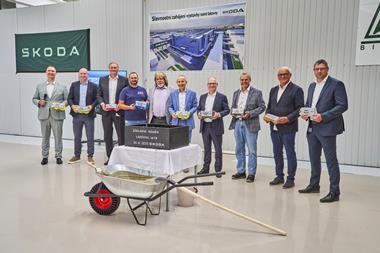Turkish alloy wheel producer Cevher Wheels has invested in Graco Pro Xpc Auto electrostatic
When it comes to spray painting alloy wheels, just how do you get the balance between obtaining a perfect finish, cutting material consumption, reducing environmental impact, minimising maintenance downtime and ensuring operational safety?
Cevher Wheels, a Turkish company producing alloy wheels for cars, has managed to achieve all five objectives. How? By taking advantage of the expertise of Graco in the electrostatic coating field, and investing in Graco’s latest and most innovative electrostatic spray gun: the Pro Xpc Auto.
Comprehensive facilities
Cevher Wheels specialises in the production of aluminium alloy wheels for world-renowned OEMs such as Volkswagen, Audi, Skoda, SEAT, FCA, Daimler, BMW and PSA. The company’s product portfolio covers aluminium alloy wheels between 14 and 18 inches. Depending on customer requirements, heat treatment and diamond cutting can also be applied.
Supported by modern casting/CNC machines, an automatic paintshop and vast experience in low-pressure die-casting methods, Cevher Wheels is able to provide the highest product quality and widest engineering and manufacturing flexibility, while offering competitive costs for its customers.
Established in 2002, the company’s 2017 turnover was over €70m ($81m), producing 1.6m wheels, nearly all of which were exported. Its production plant in Izmir, Turkey extends over an area of 44,000 sq.m, over half of which are covered. Here, the entire production process of wheels takes place, from mould design to casting and finishing. It is divided into five phases: melting of primary aluminium; low-pressure die-casting of wheels; thermal treatment; machining; and coating.
Facilities include: three melting furnaces, 28 low-pressure presses; a continuous flow heat treatment line; eight machining stations, each with three lathes; a mirror-polishing station, with five lathes and an annual capacity of 300,000 wheels; and a coating line with an annual capacity of 2m wheels. The plant also has a metallurgical testing laboratory for dimensional, dynamic and balancing checks, and a laboratory for the quality control of coatings.
Highest quality
For the finishing of alloy wheels, Cevher employs the mixed powder-liquid coating systems that are traditionally used in the wheel sector. After a 13-stage pre-treatment phase with Chemetall chemicals, an epoxy-polyester powder primer is applied.
The parts are cured at 180°C, cooled, checked for quality, and, if necessary, any defects are sanded. The liquid base coat is then applied. Cevher uses over 15 colours, although most applications require six or seven standard colours. Application of the acrylic clear coat is performed with a wet-on-wet process, featuring a 12-minute flash-off stage between the two application operations. Polymerisation occurs in a hot air oven at 150°C for 15 minutes.
At the end of the coating cycle, the wheels proceed to the final control and packaging stations. If a diamond finish is required, the wheels are mirror polished after the application of the primer and the base coat, and are then subjected to the coating cycle from the beginning (i.e. from the pre-treatment stage). Finally, two layers of clear coat are applied – a powder and a liquid one – making up a total of four layers of paint.
Innovative thinking
Having always used electrostatic technology for spraying liquid coatings, a year ago, Cevher – always keen to implement new and innovative technologies – replaced all its automatic spray guns, atomisers and control units with Graco’s Pro Xpc Auto guns. Six guns were installed in each of the two liquid coating application booths, mounted on fixed reciprocators.
All the guns are never used at the same time. Different spraying programs can be selected by the operator during loading, depending on the wheel’s design and size, which require three or four guns at a time. For instance, for 15-inch and 16-inch wheels, guns 1, 3 and 6 are used; for 17-inch and 18-inch wheels, guns 2, 4 and 6 come into play. Gun 5 is normally kept as a back-up.
Pro Xpc Auto guns explained
Graco’s Pro Xpc Auto electrostatic spray guns are versatile, compact and light, which makes them suitable for robots and reciprocators with low payloads. They are safe, durable and designed for efficient integration in various types of coating systems.
Pro Xpc Auto guns are user friendly, feature few components and are easy to disassemble, which leads to less frequent and easier maintenance operations.
The guns and the coating parameters can be controlled with a PLC or a control unit to provide spraying flexibility and process improvement. Thanks to the possibility of performing fine adjustments of the coating parameters, such as air pressure and electrostatics, significant paint savings are possible – up to 15% for some colours – as well as thickness uniformity.
Their small size and weight allow them to be used in confined spaces and corners. Patent pending charge points enable high-transfer efficiency and reduce material consumption to maximise productivity and profitability.A further key feature of these devices is safety. High voltages inside the coating booth may involve risk. To reduce this risk, the Pro Xpc Auto guns are designed with a 100kV power supply and a low-voltage connection cable. Their external controller, which generates and manages the voltage, incorporates software that detects the presence of electric arcs and automatically stops the electrostatic charge when a workpiece is too close to the gun.
Graco technology makes the difference
Since using the new Pro Xpc Auto guns, Cevher Wheels has noticed a significant decrease in overspray, resulting in a 15-20% reduction in paint consumption, depending on the colour used. Apart from the direct financial benefits, the environment also benefits as the company is producing less paint sludge and consuming fewer chemicals for its treatment.
In addition, the quality of some metallic shades is improved, since the guns’ electronic control units enable precise control and adjustment of electrostatic properties, such as voltage and current intensity. The old equipment had pneumatic controls that did not allow for the fine-tuning of these parameters.
www.graco.com








































